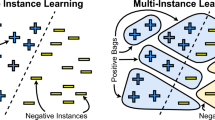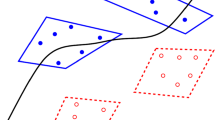Abstract
Multiple instance learning attempts to learn from a training set consists of labeled bags each containing many unlabeled instances. In previous works, most existing algorithms mainly pay attention to the ‘most positive’ instance in each positive bag, but ignore the other instances. For utilizing these unlabeled instances in positive bags, we present a new multiple instance learning algorithm via semi-supervised laplacian twin support vector machines (called Miss-LTSVM). In Miss-LTSVM, all instances in positive bags are used in the manifold regularization terms for improving the performance of classifier. For verifying the effectiveness of the presented method, a series of comparative experiments are performed on seven multiple instance data sets. Experimental results show that the proposed method has better classification accuracy than other methods in most cases.



Similar content being viewed by others
Explore related subjects
Discover the latest articles, news and stories from top researchers in related subjects.References
Dietterich TG, Lathrop RH (1997) Solving the multiple-instance problem with axis-parallel rectangles. Artif Intell 89:31–71
Maron O, Ratan AL (1998) Multiple-instance learning for natural scene classification. In: 15th international conference on machine learning. Morgan Kaufmann Publishers Inc., San Francisco, pp 341–349
Zhang Q, Goldman S (2002) Em-dd: an improved multiple instance learning technique. Adv Neural Inf Process Syst 14:1073–1080
Andrews S, Tsochantaridis I, Hofmann T (2003) Support vector machines for maultiple-instance learning, In: Advances in neural information processing systems 15, MIT Press, pp 561–568
Wang J, Zucker JD (2000) Solving the multi-instance problem: a lazy learning approach, ICML00, San Francisco, pp 1119–1125
Ruffo G (2000) Learning single and multiple instance decision trees for computer security applications, Doctoral dissertation, Department of Computer Science, University of Turin, Torino
Chevaleyre Y, Zucker JD (2001) A framework for learning rules from multiple instance data, ECML01. Freiburg, pp 49–60
Chen Y, Wang JZ (2004) Image categorization by learning and reasoning with regions. J Mach Learn Res 5:913–939
Zhou ZH, Zhang ML (2003) Ensembles of multi-instance learners, ECML03. Croatia, Cavtat- Dubrovnik, pp 492–502
Xu X, Frank E (2004) Logistic regression and boosting for labeled bags of instances, PAKDD04. Sydney, pp 272–281
Ray S, Craven M (2005) Supervised versus multiple instance learning: an empirical comparison, ICML05. Bonn, pp 697–704
Ramon J, Raedt LD (2000) Multi-instance neural networks. In: Proceedings of the ICML-2000 workshop on attribute-value and relational learning. Morgan Kaufmann Publishers, San Francisco, pp 53–60
Mangasarian OL, Wild EW (2008) Multiple instance classification via successive linear programming. J Optim Theory Appl 137(1):555–568
Yang ZX, Deng NY (2009) Multi-instance support vector machine based on convex combination, In: The 8th international symposium on operations research and its applications (ISORA09), pp 481–487
Zhang Q, Tian Y, Liu D (2013) Nonparallel support vector machines for multiple-instance learning. Procedia Comput Sci 17:1063–1072
Qi Z, Tian YJ, Yu XD, Shi Y (2014) A multi-instance learning algorithm based on nonparallel classifier. Appl Math Comput 241:233–241
Bandyopadhyay S, Ghosh D, Mitra R (2015) MBSTAR: multiple instance learning for predicting specific functional binding sites in microRNA targets. Sci Rep 5:8004–8004
Hong R, Wang M, Gao Y et al (2014) Image annotation by multiple-instance learning with discriminative feature mapping and selection. IEEE Trans Cybern 44(5):669–680
Bi J, Chen Y, Wang JZ (2005) A sparse support vector machine approach to region-based image categorization. Cvpr 1:1121–1128
Kundakcioglu OE, Seref O, Pardalos PM (2010) Multiple instance learning via margin maximization. Appl Numer Math 60(4):358–369
Zhou ZH, Jiang K, Li M (2005) Multi-instance learning based web mining. Appl Intell 22(2):135–147
Bennett KP, Demiriz A (1999) Semi-supervised support vector machines. Proc Neural Inf Process Syst 11:368–374
Fung G, Mangasarian OL (2000) Semi-supervised support vector machines for unlabeled data classification. Optim Methods Softw 15(1):29–44
Belkin M, Niyogi P, Sindhwani V (2006) Manifold regularization: a geometric framework for learning from labeled and unlabeled examples. J Mach Learn Res 7:2399–2434
Qi Z, Tian Y, Yong S (2012) Laplacian twin support vector machine for semi-supervised classification. Neural Netw 35(11):46–53
Yang Z, Xu Y (2015) Laplacian twin parametric-margin support vector machine for semi-supervised classification. Neurocomputing 171(C):325–334
Chen WJ, Shao YH, Hong N (2014) Laplacian smooth twin support vector machine for semi-supervised classification. Int J Mach Learn Cybern 5(3):459–468
Zhou ZH, Xu JM (2007) On the relation between multi-instance learning and semi-supervised learning, ICML’07. In: Proceedings of the 24th international conference on machine learning, pp 1167–1174
Rahmani R, Goldman SA (2006) MISSL: multiple-instance semi-supervised learning. In: Proceedings of the international conference on machine learning (ICML). pp 705–712
Gao XZ, Fan LY, Xu HT (2016) A novel method for classification of matrix data using twin multiple rank SMMs. Appl Soft Comput 48:546–562
Mangasarian OL, Wild EW (2008) Multiple instance classification via successive linear programming. J Optim Theory Appl 137(1):555–568
Murphy PM, Aha DW Uci machine learning repository, www.ics.uci.edu/mlearn/mlrepository.html
Nie FP, Wang XQ et al. (2016) The Constrained Laplacian Rank Algorithm for graph-based clustering. In: Proceedings of the 13th AAAI conference on artificial intelligence (AAAI-16)
Acknowledgements
This work is supported by the National Science Foundation of China under Grant Nos. 61273251 and 61673220.
Author information
Authors and Affiliations
Corresponding author
Rights and permissions
About this article
Cite this article
Gao, X., Sun, Q. & Xu, H. Multiple Instance Learning via Semi-supervised Laplacian TSVM. Neural Process Lett 46, 219–232 (2017). https://doi.org/10.1007/s11063-017-9579-5
Published:
Issue Date:
DOI: https://doi.org/10.1007/s11063-017-9579-5




